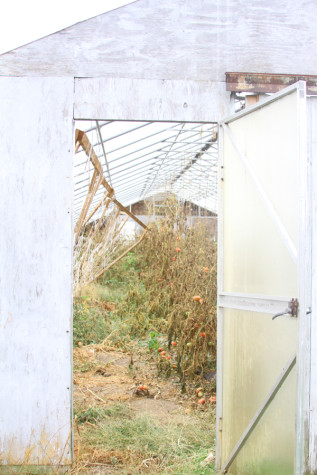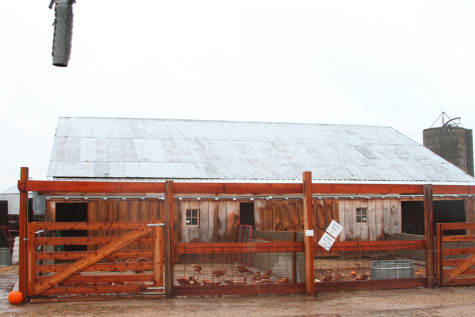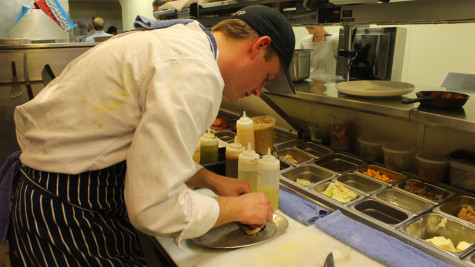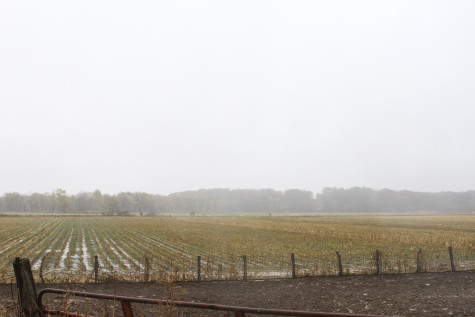Your donation will support the student journalists of Iowa City High School. For 2023, we are trying to update our video and photo studio, purchase new cameras and attend journalism conferences.
Farm to Table
Two local businesses—a farm and a restaurant—are teaming up to bring people closer to the food they eat.
November 6, 2015
Food travels an average of 1,500 miles, often times across state and national borders, to get from the farm where it’s grown to the consumer. However, there is a new movement to narrow the gap between consumers and the source of their food. Kroul Farms, a family operation based in Mount Vernon, is one of the many farms who are taking part in what has been called the ‘farm-to-table movement’ by trying to bring produce to people closer to home.

“The whole farm-to-table movement to me is about people taking back the power of what goes in their bodies,” Matt Kroul, said. “Knowing your farmer and knowing where your food comes from is a huge deal to us.”
Kroul’s family has been farming for generations, but about 20 years ago they began growing more varied produce in place of some of their corn and soybean crops. Since then, they have found a number of ways to get their produce to local consumers, including the establishment of a community-supported agriculture program, selling at local farmers markets, and providing food for nearby restaurants.
One of the reasons why the Krouls chose to begin growing produce was to bring their products to a broader market and to make better use of their land.

“We try to diversify crops and find methods of cash flow from different markets,” Kroul said. “From the acres that we have, we try and maximize what we can do.”
In the past two years, the Krouls have further expanded their market by supplying their fresh produce to restaurants Abe Grogan is a City High alumnus and the sous chef at Big Grove Brewery, which works closely with Kroul Farms. The restaurant’s goal of sourcing most of its produce and meat locally was prompted by Executive Chef Benjamin Smart’s experience at a restaurant in Washington that saw success through using farm-fresh produce.
“From day one, we’ve been on a mission to be a farm-to-table, from-scratch kitchen. We feel like that’s something that a lot of places don’t necessarily try to do,” Grogan said. “We just want to try to elevate people’s expectations as far as food is concerned.”
Grogan estimates that up to 50 percent of the food product is sourced locally during the summer months, and about 10 percent is during the winter. Each month, he and Smart build their menu around items that they can source locally. While such constraints can sometimes be challenging, Grogan also sees it as an opportunity for creativity. For instance, they use vacuum-packed and pickled fruits and vegetables as well as seasonal produce to incorporate local food into their dishes year-round.
“Seasonality can be an issue, but we’ve gotten fairly accustomed to it,” Grogan said. “It’s a challenge [to source our food locally], but I enjoy the challenge, and also it’s important because you want to put the best food out there, and to do that, you need to use the food that is in season.”

While the chefs at Big Grove have found many ways to work with seasonal availability of fresh food from local farms, they acknowledge that it’s not always possible.
“From day one, the plan was to use as much local food as possible. It’s not always economically feasible, like in the middle of January when there’s not a lot of local product available,” Grogan said. “We’re also a very high volume restaurant, so in certain cases the farmers aren’t able to keep up with our demand.”
The seasonal variability of the Iowa climate can also be difficult for local farmers. However, Kroul Farms manages to maintain year-round operations by keeping a diverse array of crops and livestock. In the winter, for instance, when corn and pumpkins have all been harvested, the Krouls shift their focus to raising cattle.
“I think it’s more work than some people would like,” Kroul said of keeping the farm running through all seasons. “There isn’t really a down time for us.”
Their diversity in crops and livestock also allows the Krouls more financial stability, even in the face of uncertain weather and environmental conditions.

“We have a balance of [crops and livestock],” Kroul said. “We call it ‘self-insurance’ because if it’s a bad year for corn and beans then we can pick more pumpkins or cut more firewood.”
Kroul Farms tries to bring an element of education and experience to their customers. However, the owners also try to keep their farm simple, and to stay away from becoming a part of the agritourism industry. Instead, they aim to make people more aware of the sources of their food through education and personal connection with their farm.
“We get kind of spoiled, going to Hy-Vee where we have everything we could ever want, but in Iowa that stuff doesn’t grow all year round, and hopefully [the consumers] understand that,” he said.
Some restaurants are deterred from using locally sourced food because they worry about the heightened costs. Grogan, however, argues that the cost is only 25 to 50 cents more per dish, and that extra cost it is often offset by customers’ enthusiasm for the food and the direct connection to farms.

“[Local ingredients] just means better food. It means that the food is fresher, you know where it came from, and you know the process that it went through,” Grogan said.
When Big Grove cannot be supplied locally, they are supplied by major food corporation Sysco. However, according to Grogan, Sysco’s recent effort to source local food indicates a shift in the prominence of the farm-to-table movement. In fact, Grogan foresees the movement maintaining the momentum that it has gained in recent years.
“I really feel like that’s just a selling point, and I think that restaurants are going to see that,” he said. “I think that once people taste the difference, there’s no way that they could go back.”